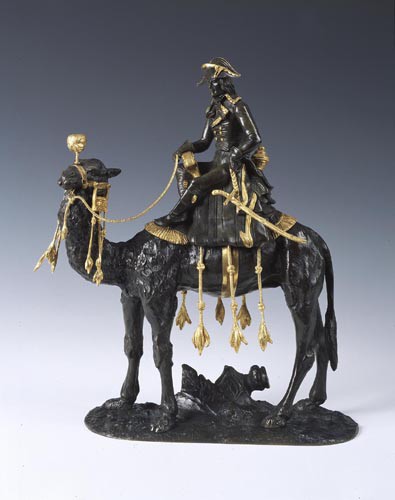In the second volume of A. C. Thibaudeau's Histoire générale de Napoléon Bonaparte – released in 1828 and entitled Guerre d'Egypte – the author wrote: “Thanks to the speed of their horses, their skilled handling of them, [and] their accustomance to life in the desert, the Arabs all too often made their escape from the French cavalry, who would exhaust themselves in their pursuit. Upon his arrival in Suez from Asia, the Général en chef [Napoleon Bonaparte] met some Arabs escorting a caravan on dromedaries. Noticing the skill with which they rode these animals, the general ordered Eugène Beauharnais and Edouard Colbert – today Lieutenant-General – to attempt to mount and ride a camel. These officers executed the general's order with ease [to such an extent that] the latter was forced to gallop after them. Unable to catch up, Bonaparte declared that within a month, he would have a regiment of dromedaries, charged with policing Egypt.” And so, on 20 Nivôse Year VII (9 January, 1799), Bonaparte created his dromedary regiment, tasked with leading the fight against the insurgents who had brought their struggle to the very gates of Cairo. The speed, manoeuvrability and docility of the animals, coupled with their ability to withstand the extreme conditions of the desert, made them a precious asset during the Egyptian campaign. Bonaparte himself rode a camel, and the Musée Africain de l'Île d'Aix still holds today the dromedary (now stuffed) (external link in French) believed to have been used by the French general. The dromedary regiment disbanded shortly after its creator's departure.
The image of Napoleon on a dromedary is striking, and the artists of the time were extremely taken by its air of exoticism, the perfect incarnation of the wave of orientalism that swept the nineteenth century. This anonymously-produced small bronze statue, part of the Fondation Napoléon's collection, is an arresting yet slightly comical representation of this image. A similar model (external link in French) – without the rich gilt bronze decoration seen in the above example – also exists and is held at the Musée National de Malmaison. The base on this latter version is signed by a certain Meurant, a sculptor historians have struggled to identify with any certainty. The golden highlights on Bonaparte's hat, uniform and sabre, taken with the gilt bronze harnesses and saddle trappings of the dromedary, contribute to the refinement, even preciosity, of this statuette, which ably captures the spirit, dreams and fantasies inspired by the Egyptian campaign.
Karine Huguenaud (tr. H.D.W.)
June 2011
Bonaparte on a dromedary

- Date :
- Second half of the 19th century
- Technique :
- Fine-cut, partly gilt bronze patina
- Dimensions :
- H = 37 cm, L = 27 cm, P = 12 cm
- Place held :
- Paris, Fondation Napoléon, donation Martial Lapeyre
- Photo credit :
- © Fondation Napoléon - P. Maurin-Berthier

